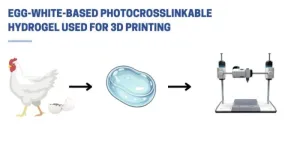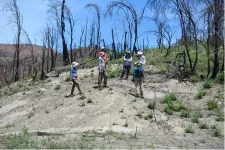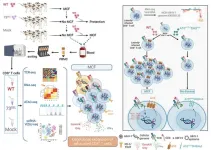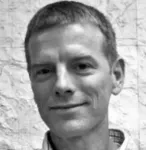(Press-News.org) Elon Musk recently declared on X that Blindsight, a cortical implant to restore vision, would have low resolution at first “but may ultimately exceed normal human vision.”
That pronouncement is unrealistic at best, according to new research from the University of Washington.
Ione Fine, lead author and UW professor of psychology, said Musk’s projection for the latest Neuralink project rests on the flawed premise that implanting millions of tiny electrodes into the visual cortex, the region of the brain that processes information received from the eye, will result in high-resolution vision.
For the study, published online July 29 in Scientific Reports, the researchers created a computational model that simulates the experience of a wide range of human cortical studies, including an extremely high-resolution implant like Blindsight. One simulation shows that a movie of a cat at a resolution of 45,000 pixels is crystal-clear, but a movie simulating the experience of a patient with 45,000 electrodes implanted in the visual cortex would perceive the cat as blurry and barely recognizable.
That’s because a single electrode doesn’t represent a pixel, Fine said, but instead stimulates, at best, a single neuron.
On a computer screen, pixels are tiny ‘dots.’ But that’s not the case in the visual cortex. Instead, each neuron tells the brain about images within a small region of space called the “receptive field,” and the receptive fields of neurons overlap. This means that a single spot of light stimulates a complex pool of neurons. Image sharpness is determined not by the size or number of individual electrodes, but the way information is represented by thousands of neurons in the brain.
“Engineers often think of electrodes as producing pixels,” Fine said, “but that is simply not how biology works. We hope that our simulations based on a simple model of the visual system can give insight into how these implants are going to perform. These simulations are very different from the intuition an engineer might have if they are thinking in terms of a pixels on a computer screen.”
The researchers’ approach was to use a wide range of animal and human data to generate computational “virtual patients” that show, for the first time, how human electrical stimulation in the visual cortex might be experienced. Even blurry vision would be a life-changing breakthrough for many people, Fine said, but these simulations — which represent the likely best-case scenario for visual implants — suggest that caution is appropriate.
While Fine said Musk is making important strides in the engineering challenge of visual implants, a big obstacle remains: Once the electrodes are implanted and stimulating single cells, you still need to recreate a neural code — a complex pattern of firing over many thousands of cells — that creates good vision.
“Even to get to typical human vision, you would not only have to align an electrode to each cell in the visual cortex, but you’d also have to stimulate it with the appropriate code,” Fine said. “That is incredibly complicated because each individual cell has its own code. You can’t stimulate 44,000 cells in a blind person and say, ‘Draw what you see when I stimulate this cell.’ It would literally take years to map out every single cell.”
So far, Fine said scientists have no idea of how to find the correct neural code in a blind individual.
“Somebody might one day have a conceptual breakthrough that gives us that Rosetta Stone,” Fine said. “It’s also possible that there can be some plasticity where people can learn to make better use of an incorrect code. But my own research and that of others shows that there’s currently no evidence that people have massive abilities to adapt to an incorrect code.”
Without that sort of development, the vision provided by Blindsight and similar projects will remain fuzzy and imperfect — no matter how sophisticated the electronic technology.
For now, the models developed in the study could be used by researchers and companies to aid in the placement of existing devices and the development of new technology, among other benefits. Entities like the Food and Drug Administration and Medicare could also gain insight into what sort of tests are important when evaluating devices. Further, the models provide realistic expectations for surgeons, patients and their families.
“Many people become blind late in life,” Fine said. “When you’re 70 years old, learning the new skills required to thrive as a blind individual is very difficult. There are high rates of depression. There can be desperation to regain sight. Blindness doesn’t make people vulnerable, but becoming blind late in life can make some people vulnerable. So, when Elon Musk says things like, ‘This is going to better than human vision,’ that is a dangerous thing to say.”
Geoffrey Boynton, UW professor of psychology, was a co-author. The research was funded by the National Institutes of Health.
For more information, contact Fine at ionefine@uw.edu.
END
UW model shows cortical implants like Elon Musk’s Blindsight unlikely to ‘exceed normal human vision’
2024-07-29
ELSE PRESS RELEASES FROM THIS DATE:
UVA's Data Justice Academy receives new funding from NSF
2024-07-29
The National Science Foundation will provide funding to the University of Virginia’s Data Justice Academy, the agency recently announced, support that will help the summer program continue to serve undergraduate students from groups that are historically underrepresented in data science.
Established in 2021, the Data Justice Academy provides a 10-week residential experience to participants in which they perform mentored research while learning technical skills.
The overriding goal of the Data Justice Academy, which is jointly managed by UVA’s School of Data Science and Equity Center, ...
Orthopedic surgeon-scientist Dr. Frank Henn named Chair of the Department of Orthopaedics
2024-07-29
University of Maryland School of Medicine (UMSOM) Dean Mark T. Gladwin, MD, announced today that R. Frank Henn, III, MD, Professor of Orthopaedics, who has served as Interim Chair of the Department since 2022, has been appointed to serve as the new Chair of UMSOM’s Department of Orthopaedics, effective immediately.
Dr. Henn, who joined the Department in 2010, is an academic leader and highly regarded, board-certified orthopaedic surgeon; he has published significant scientific research, and is a leading clinician focusing on the care of the shoulder and knee, with an emphasis in cartilage ...
Nature inspires a breakthrough: scientists develop revolutionary egg white-based bioink for advanced tissue engineering
2024-07-29
Los Angeles, California – July 29, 2024 - Terasaki Institute scientists have created a cutting-edge technology inspired by nature by developing a novel bioink derived from egg whites or Egg White methacryloyl (EWMA). Bioinks are mainly used in 3D bioprinting to create artificial tissues. These natural or synthetic materials support living cells, aiding their adhesion, growth, and differentiation. They are essential for developing complex tissue structures for medical research, drug testing, and organ transplantation. This novel EWMA bioink represents a promising addition to this field, offering a unique combination of properties that address many challenges faced in tissue engineering.
The ...
California a botanical and climate change hot spot
2024-07-29
From coastal redwoods and Joshua trees to golden poppies and sagebrush, California is a global botanical hotspot. It’s also a place confronted with extreme heat, wildfires and crumbling coastlines. The state’s natural beauty and history of pioneering conservation efforts make it a test bed for protecting biodiversity in the face of current and future climate change, argues a study led by the University of California, Davis.
Published July 29 in Proceedings of the National Academy of Sciences, the study, “Climate Change and California’s Terrestrial Biodiversity,” is part of a special ...
Young scientists face career hurdles in interdisciplinary research
2024-07-29
COLUMBUS, Ohio – Scientists agree that solving some of society’s greatest challenges in biomedicine such as food sustainability, aging and disease treatment will need researchers from a variety of scientific fields working together.
But a new study finds that the young scientists who most embrace interdisciplinary research face “career impediments” not seen in their peers who focus their work only within their own disciplines.
The results are troublesome and pose a “grave challenge” to efforts to increase interdisciplinary ...
New progress in research into malignant catarrhal fever in cattle
2024-07-29
A research team led by University of Liège scientists has published a groundbreaking study on malignant catarrhal fever (MCF). This disease is caused by the alcelaphine gammaherpesvirus 1 (AlHV-1), which infects its natural host, the wildebeest. This study sheds light on the mechanisms by which this virus, which is asymptomatic and latent in the wildebeest, causes an oligoclonal expansion of CD8+ T lymphocytes in cattle, leading to the development of MCF.
In 2013, the research team had already demonstrated (1) that malignant catarrhal fever (MCF), which is fatal in cattle, only develops if the AlHV-1 virus can maintain a ...
Words like ‘this’ and ‘that’ act as attention tools across languages
2024-07-29
All languages have words like ‘this’ and ‘that’ to distinguish between referents that are ‘near’ and ‘far’. Languages like English or Hebrew have two of these ‘demonstratives’. Languages like Spanish or Japanese use a three-word system. For instance, in Spanish, ‘este’ signals something close to the speaker, ‘ese’ signals something far from the speaker but close to the listener, and ‘aquel’ signals something far from both.
“The reason why we were interested in demonstratives is because of their ...
Local food production saves costs and carbon
2024-07-29
Local foods are critical to the food security and health of Indigenous peoples around the world, but local "informal" economies are often invisible in official economic statistics. Consequently, these economies may be overlooked in the policies designed to combat climate change. For instance, Indigenous communities in the North American Arctic are characterized by mixed economies featuring hunting, fishing, gathering and trapping activities, alongside the formal wage economy. The region is also undergoing a rapid transformation due to social, economic and climatic changes. In Canada, the introduction ...
Bold moves needed for California agriculture to adapt to climate change
2024-07-29
California should take urgent and bold measures to adapt its $59 billion agriculture sector to climate change as the amount of water available for crops declines, according to a collaborative report by University of California faculty from four campuses.
Published in the Proceedings of the National Academy of Sciences, the report provides a roadmap for more water capture, storage, and distribution systems that are in harmony with climate projections and ecosystems. It further considers how runoff and groundwater can be used repeatedly ...
To get drivers to put down their phones, make it a game
2024-07-29
If you’re trying to keep drivers from picking up their phones, make it a game, according to a new Proceedings of the National Academy of Sciences (PNAS) study led by researchers from the Perelman School of Medicine at the University of Pennsylvania. When drivers could earn points for making reductions in handheld phone use and had the chance to compete in a weekly leaderboard of others like them, researchers saw as much as a 28 percent reduction in handheld phone use while driving, a habit that stuck once the intervention—and the games—ended.
“Distracted driving ...






